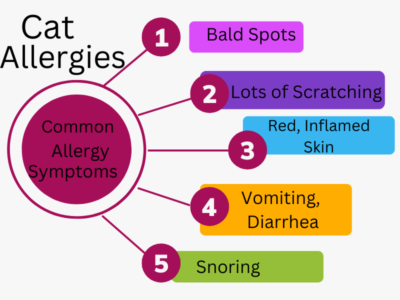Have you had a cat who developed allergies? They prove actually fairly common in cats. Your cat does his best to get rid of the irritating symptoms, but often you and/or your vet may have to intervene to take care of the problem. Therefore, do you know how to treat cats with allergies?
What Is An Allergy?
An allergy can be defined as an abnormal immune response to a harmless stimulus. Kitty’s body contacts an allergen through his skin or after breathing it in. Then a chain reaction starts, which is out of proportion to kitty’s danger. It’s called a hypersensitivity reaction.

Usually a cat does not arrive in the world with allergies. These nasty reactions to some allergen develop as the cat ages. Allergies become most often diagnosed between six months and three years. However, diagnosis is often difficult and sometimes older cats develop them, too.
Allergy Types And Causes
Listed below you will find a short description of the four common cat allergies. These include environmental, fleas, food, and seasonal. Learn how these might affect your cat.
- Environmental allergies: Many substances can cause problems, including pollen, grass, fungi, mold, and dust. Your cat may also have a sensitivity to cigarette smoke, perfume, and some common cleaning products.
- Flea allergies: If you live in an area where there are fleas, know that these small insects can cause your cat great misery. The flea’s saliva can affect the cat’s entire body, not just the location of the bite. You need superior flea protection for your cat.
- Food allergies: Your cat might become allergic to certain foods. It might be one he has eaten without a problem for some time, but that can change. These allergies can cause skin itchiness, vomiting, or diarrhea. Consult your vet to find what your cat can eat.
- Atopic dermatitis: This is a skin condition that kitty’s body might develop if he has this condition. With atopic dermatitis, he may develop skin sores, scabbing, hair loss, and redness.
Some Symptoms Of Cat Allergies
- Itching or overgrooming: Does your kitty scratch with his paws at an itchy spot? Does he do so often? Does he overgroom that itchy skin so much that it leads to patches of hair loss? He might also be more prone to ear infections
- Your cat might have a skin reaction called “miliary dermatitis.” This reaction causes hundreds of small rash-like, scabby lesions on kitty’s skin,especially along the back and neck.
- If kitty has an allergy to airborne allergens such as pollen, he might show such symptoms as runny eyes, itchy eyes, sneezing, coughing, or fast breathing.
- The kitty with food allergies might show some gastrointestinal symptoms, such as diarrhea, lots of gas, and occasional vomiting.

The Diagnosis Of Cat Allergies
How do you diagnose cat allergies? Though simple in theory, it can actually take a long time to figure out the problem. Start with flea allergy, since it is most common. Rule out flea allergy as the cause of kitty’s symptoms.
To see if fleas are the problem, apply prescription-strength flea treatment to all animals in the house for at least 12 weeks without a break. It’s necessary to do so to ensure that the flea life-cycle is broken. If your cat then improves, a flea allergy will be presumed.
Next, rule out food. In order to do so, you must feed a hypoallergenic exclusion diet. This one can be either a prescription hydrolysed diet or a new protein different from the food kitty normally eats. This diet needs to be fed to kitty for eight weeks to see if your cat will respond.
You might want to shut them in the house during this time to make sure they don’t go to the neighbor’s house and eat. If kitty improves, food allergy is likely. To test, give them a bit of their old diet and see if the allergic symptoms reoccur.
If it’s not fleas or food, it must be something in the environment. These are a bit trickier to diagnose. You’ll need your vet, as the cat must endure blood tests or skin tests using subcutaneous injections to test for a response.
Treatment For Your Cat’s Allergies
Your first step is to attempt to keep allergens from entering your cat’s environment. Here are some things you can do:
- Be sure you have a good, approved flea and tick control in place
- Use dust-free cat litter
- Keep your home clean: No dirt or dust and no mildew
- Wash kitty’s bedding regularly; you might try hypoallergenic bedding
- Don’t smoke around your pets
- Make sure kitty has a healthy diet
- Keep kitty indoors and windows closed on high-pollen days
- Your vet may provide a daily prescription or dietary supplements.
 Treatments available for cat allergies include the following:
Treatments available for cat allergies include the following:
- Cortisone pills (to stop itching)
- Lotions, ointments, ear drops or eye drops
- Antihistamines
- Flea prevention products
Be sure to consult your vet before trying a new medication.
Is There A Relationship Between Cat Allergies And Asthma?
If your cat has asthma, he is more likely to experience cat allergies. If the cat has both asthma and allergies, your veterinarian can prescribe a medication to help open kitty’s airway temporarily. If treated long-term, medications such as corticosteroids may be used.
Suggested Ways To Treat Your Cat At Home
From the website, whiteoakvet.com, come some remedies you can make at home that may help relieve your cat’s allergies. Try these if you feel they could help.
PINE BARK EXTRACT: Give only as a supplement. This extract has excellent antioxidant properties, and is supportive of the systems controlling inflammation. It also inhibits the release of histamine from mast cells, as the histamine triggers allergic systems if an allergen is present.
For dosage, check the human dosing recommendations; then, give the cat 1/8 to 1/4 of the recommended amount.
APPLE CIDER VINEGAR: Add a small amount of this vinegar to your cat’s food. (Do not use white vinegar.) Start by adding 1/4 teaspoon to food twice daily for cats who weigh less than 12 pounds. For a cat weighing more, add 1/2 teaspoon.
Gradually increase the amount of vinegar until you reach 1/4 teaspoon per four pounds of body weight. The apple cider vinegar boosts kitty’s stomach acid, thus aiding digestion. If digested efficiently, often food intolerances are eliminated.
COCONUT OIL: Add a small spoonful at each feeding. Internally, the oil helps skin conditions as well as relieving allergies because of its antioxidant effect. It also helps the cat’s digestive system. As the oil has antiseptic properties, it can soothe allergic sores and broken skin.
Externally, the oil will treat ear mites, mange, and dry, itchy skin symptoms. Because it has antibacterial and anti-fungal properties, it can also keep bacterial and fungal infections away.
It is not often easy to figure out what your kitty is allergic to, but if you can discover the cause and eliminate it, you will have a much happier, healthier cat.
References I used for this post: whiteoakvet.com/how-to-treat-your-cats-allergies-at-home/ allaboutcats.com/allergies-in-cats pets.webmd.com/cats/cat-allergy-symptoms-triggers hillspet.com/cat-care/healthcare/cat-food-allergies-and-intolerance


Very interesting!
It’s a hard problem to figure out, but hopefully I’ve given some helpful suggestions.